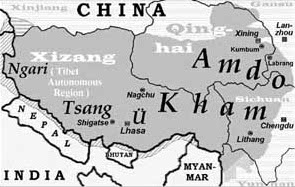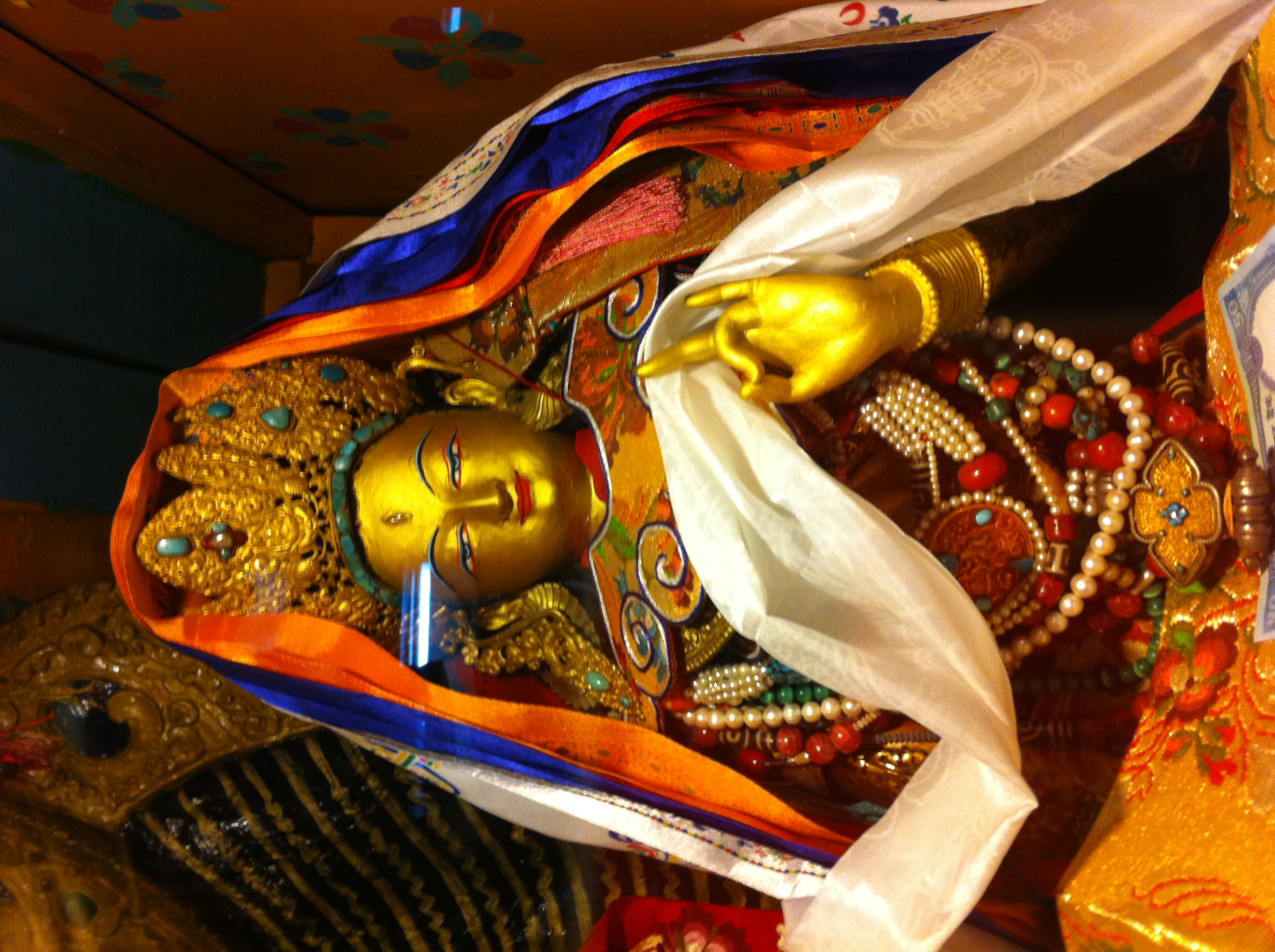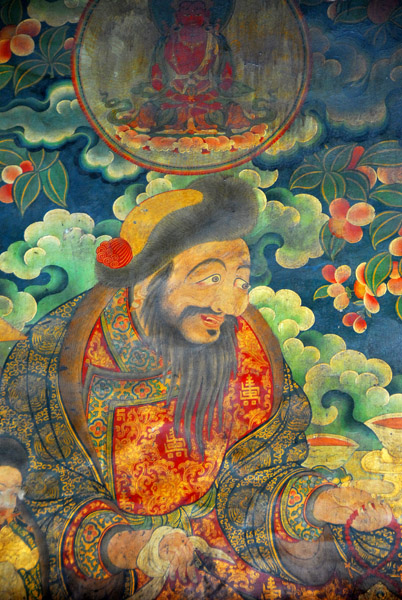|
Drongtse Monastery
Drongtse Monastery ('Brong rtse; Pinyin: Zhongze) is a Tibetan Buddhist monastery was formerly one of the most important Gelug monasteries in Tsang, Tibet. There was also a chorten there. Drongtse Monastery, is 19 km northwest of Gyantse and 14 km north of Tsechen Monastery, on the "Southern Friendship Highway" to Shigatse, and just 6 km south of the site of the early Tsi Nesar temples. It was almost totally destroyed during the Cultural Revolution, but has been partially restored since, and the Assembly Hall was rebuilt in the 1980s, though many of the main buildings remain in ruins. The original four-storied monastery was on a "rocky eminence" about 300 ft (91 m) above the village. The wall was already partly ruined when Sarat Chandra Das visited in 1881. The ''du-khang'' or congregation hall, which could seat about eighty monks, contained some very old gilt images including one of Jowo Shakyamuni said to be a copy by an Indian artist of the famous and much-revered image ... [...More Info...] [...Related Items...] OR: [Wikipedia] [Google] [Baidu] |
Ü-Tsang
Ü-Tsang is one of the three traditional provinces of Tibet, the others being Amdo in the north-east, and Kham in the east. Ngari (including former Guge kingdom) in the north-west was incorporated into Ü-Tsang. Geographically Ü-Tsang covered the south-central of the Tibetan cultural area, including the Brahmaputra River watershed. The western districts surrounding and extending past Mount Kailash are included in Ngari, and much of the vast Changtang plateau to the north. The Himalayas defined Ü-Tsang's southern border. The present Tibet Autonomous Region corresponds approximately to what was ancient Ü-Tsang and western Kham. Ü-Tsang was formed by the merging of two earlier power centers: Ü () in central Tibet, controlled by the Gelug lineage of Tibetan Buddhism under the early Dalai Lamas, and Tsang () which extended from Gyantse to points west, controlled by the rival Sakya lineage. Military victories by the powerful Khoshut Mongol Güshi Khan that backed 5th Dalai ... [...More Info...] [...Related Items...] OR: [Wikipedia] [Google] [Baidu] |
Lozang Gyatso
Ngawang Lobsang Gyatso (; ; 1617–1682) was the 5th Dalai Lama and the first Dalai Lama to wield effective temporal and spiritual power over all Tibet. He is often referred to simply as the Great Fifth, being a key religious and temporal leader of Tibetan Buddhism and Tibet. Gyatso is credited with unifying all Tibet under the Ganden Phodrang after a Mongol military intervention which ended a protracted era of civil wars. As an independent head of state, he established relations with the Qing empire and other regional countries and also met early European explorers. Gyatso also wrote 24 volumes' worth of scholarly and religious works on a wide range of subjects. Early life To understand the context within which the Dalai Lama institution came to hold temporal power in Tibet during the lifetime of the 5th, it may be helpful to review not just the early life of Lobsang Gyatso but also the world into which he was born, as Künga Migyur. Künga Migyur's family The child who would ... [...More Info...] [...Related Items...] OR: [Wikipedia] [Google] [Baidu] |
Buddhist Temples In Tibet
Buddhism ( , ), also known as Buddha Dharma and Dharmavinaya (), is an Indian religion or philosophical tradition based on teachings attributed to the Buddha. It originated in northern India as a -movement in the 5th century BCE, and gradually spread throughout much of Asia via the Silk Road. It is the world's fourth-largest religion, with over 520 million followers (Buddhists) who comprise seven percent of the global population. The Buddha taught the Middle Way, a path of spiritual development that avoids both extreme asceticism and hedonism. It aims at liberation from clinging and craving to things which are impermanent (), incapable of satisfying ('), and without a lasting essence (), ending the cycle of death and rebirth (). A summary of this path is expressed in the Noble Eightfold Path, a training of the mind with observance of Buddhist ethics and meditation. Other widely observed practices include: monasticism; " taking refuge" in the Buddha, the , and the ; ... [...More Info...] [...Related Items...] OR: [Wikipedia] [Google] [Baidu] |
Buddhist Monasteries In Tibet
Buddhism ( , ), also known as Buddha Dharma and Dharmavinaya (), is an Indian religion or philosophical tradition based on teachings attributed to the Buddha. It originated in northern India as a -movement in the 5th century BCE, and gradually spread throughout much of Asia via the Silk Road. It is the world's fourth-largest religion, with over 520 million followers (Buddhists) who comprise seven percent of the global population. The Buddha taught the Middle Way, a path of spiritual development that avoids both extreme asceticism and hedonism. It aims at liberation from clinging and craving to things which are impermanent (), incapable of satisfying ('), and without a lasting essence (), ending the cycle of death and rebirth (). A summary of this path is expressed in the Noble Eightfold Path, a training of the mind with observance of Buddhist ethics and meditation. Other widely observed practices include: monasticism; " taking refuge" in the Buddha, the , and the ; ... [...More Info...] [...Related Items...] OR: [Wikipedia] [Google] [Baidu] |
Tara (Buddhism)
Tara ( sa, तारा, ; bo, སྒྲོལ་མ, ), Ārya Tārā, or Shayama Tara, also known as Jetsun Dölma (Tibetan: ''rje btsun sgrol ma'') is an important figure in Buddhism, especially revered in Tibetan Buddhism. She appears as a female bodhisattva in Mahayana Buddhism, and as a female Buddha in Vajrayana Buddhism. She is known as the "mother of liberation", and represents the virtues of success in work and achievements. She is known as ''Duōluó Púsà'' (多羅菩薩) in Chinese Buddhism, and as ''Tara Bosatsu'' (多羅菩薩) in Japan. Tārā is a meditation deity revered by practitioners of the Tibetan branch of Vajrayana Buddhism to develop certain inner qualities and to understand outer, inner and secret teachings such as karuṇā (compassion), mettā (loving-kindness), and shunyata (emptiness). Tārā may more properly be understood as different aspects of the same quality, as bodhisattvas are often considered personifications of Buddhist methods. Ther ... [...More Info...] [...Related Items...] OR: [Wikipedia] [Google] [Baidu] |
Padmasambhava
Padmasambhava ("Born from a Lotus"), also known as Guru Rinpoche (Precious Guru) and the Lotus from Oḍḍiyāna, was a tantric Buddhist Vajra master from India who may have taught Vajrayana in Tibet (circa 8th – 9th centuries)... According to some early Tibetan sources like the ''Testament of Ba'', he came to Tibet in the 8th century and helped construct Samye Monastery, the first Buddhist monastery in Tibet. However, little is known about the actual historical figure other than his ties to Vajrayana and Indian Buddhism. Padmasambhava later came to be viewed as a central figure in the transmission of Buddhism to Tibet. Starting from around the 12th century, hagiographies concerning Padmasambhava were written. These works expanded the profile and activities of Padmasambhava, now seen as taming all the Tibetan spirits and gods, and concealing various secret texts ('' terma'') for future tertöns. Nyangral Nyima Özer (1124–1192) was the author of the ''Zangling-ma'' (Jew ... [...More Info...] [...Related Items...] OR: [Wikipedia] [Google] [Baidu] |
Tashilhunpo
Tashi Lhunpo Monastery (), founded in 1447 by the 1st Dalai Lama, is the traditional monastic seat of the Panchen Lama, and an historically and culturally important monastery in Shigatse, the second-largest city in Tibet. The monastery was sacked when the Gorkha Kingdom invaded Tibet and captured Shigatse in 1791 before a combined Tibetan and Chinese army drove them back as far as the outskirts of Kathmandu, when they were forced to agree to keep the peace in the future, pay tribute every five years, and return what they had looted from Tashi Lhunpo. The monastery is the traditional seat of successive Panchen Lamas, the second highest ranking tulku lineage in the Gelug tradition of Tibetan Buddhism. The "Tashi" or Panchen Lama had temporal power over three small districts, though not over the town of Shigatse itself, which was administered by a ''dzongpön'' (prefect) appointed from Lhasa. Located on a hill in the center of the city, the full name in Tibetan of the monastery ... [...More Info...] [...Related Items...] OR: [Wikipedia] [Google] [Baidu] |
Tsongkhapa
Tsongkhapa ('','' meaning: "the man from Tsongkha" or "the Man from Onion Valley", c. 1357–1419) was an influential Tibetan Buddhist monk, philosopher and tantric yogi, whose activities led to the formation of the Gelug school of Tibetan Buddhism.Tsong khapa (2006), pp. ix-x. He is also known by his ordained name Losang Drakpa (, Skt. Sumatikīrti) or simply as "Je Rinpoche" (, "Precious Lord"). He is also known by Chinese as Zongkapa Lobsang Zhaba or just Zōngkàbā (宗喀巴). Tsongkhapa was born in Amdo, the son of a Tibetan Longben Tribal leader who also once served as an official of the Yuan Dynasty. As a monk, he studied under numerous teachers of the various Tibetan Buddhist traditions which flourished in central Tibet, including Sakya, Jonang, Kagyu and Kadam. Tsongkhapa was a prolific author with a broad knowledge of Buddhist philosophy, logic, hermeneutics and practice. He wrote numerous works on madhyamaka philosophy (such as ''Ocean of Reasoning,'' a comment ... [...More Info...] [...Related Items...] OR: [Wikipedia] [Google] [Baidu] |
Ascetic
Asceticism (; from the el, ἄσκησις, áskesis, exercise', 'training) is a lifestyle characterized by abstinence from sensual pleasures, often for the purpose of pursuing spiritual goals. Ascetics may withdraw from the world for their practices or continue to be part of their society, but typically adopt a frugal lifestyle, characterised by the renunciation of material possessions and physical pleasures, and also spend time fasting while concentrating on the practice of religion or reflection upon spiritual matters. Various individuals have also attempted an ascetic lifestyle to free themselves from addictions, some of them particular to modern life, such as money, alcohol, tobacco, drugs, entertainment, sex, food, etc. Asceticism has been historically observed in many religious traditions, including Buddhism, Jainism, Hinduism, Islam, Christianity, Judaism, Stoicism and Pythagoreanism and contemporary practices continue amongst some religious followers. The practition ... [...More Info...] [...Related Items...] OR: [Wikipedia] [Google] [Baidu] |
Yogin
A yogi is a practitioner of Yoga, including a sannyasin or practitioner of meditation in Indian religions.A. K. Banerjea (2014), ''Philosophy of Gorakhnath with Goraksha-Vacana-Sangraha'', Motilal Banarsidass, , pp. xxiii, 297-299, 331 The feminine form, sometimes used in English, is yogini. Yogi has since the 12th century CE also denoted members of the Nath siddha tradition of Hinduism, and in Hinduism, Buddhism and Jainism, a practitioner of tantra.Rita Gross (1993), ''Buddhism After Patriarchy'', SUNY Press, , pages 85–88 In Hindu mythology, the god Shiva and the goddess Parvati are depicted as an emblematic yogi–yogini pair. Etymology In Classical Sanskrit, the word ''yogi'' (Sanskrit: masc ', योगी; fem ') is derived from ''yogin'', which refers to a practitioner of yoga. ''Yogi'' is technically male, and ''yoginī'' is the term used for female practitioners. The two terms are still used with those meanings today, but the word ''yogi'' is also used gen ... [...More Info...] [...Related Items...] OR: [Wikipedia] [Google] [Baidu] |
Güshi Khan
Güshi Khan (1582 – 14 January 1655; ) was a Khoshut prince and founder of the Khoshut Khanate, who supplanted the Tumed descendants of Altan Khan as the main benefactor of the Dalai Lama and the Gelug school of Tibetan Buddhism. In 1637, Güshi Khan defeated a rival Mongol prince Choghtu Khong Tayiji, a Kagyu follower, near Qinghai Lake and established his khanate in Tibet over the next years. His military assistance to the Gelug school enabled the 5th Dalai Lama to establish political control over Tibet. Name It is also spelled Gushri Khan and Gushihan. In other languages it is: * Chinese: 固始汗 * mn, ᠭᠦᠱᠢ ᠬᠠᠭᠠᠨ (Гүш хаан), * bo, གུ་ཤྲཱི་བསྟན་འཛིན Early years Güshi Khan was born Torobaikhu, the third son of Akhai Khatun and Khanai Noyan Khonggor, chief of the Khoshuts. He was descended from a younger brother of Genghis Khan, Qasar. At the age of 12, Torobaikhu had already won renown in battle against the ... [...More Info...] [...Related Items...] OR: [Wikipedia] [Google] [Baidu] |




.jpg)


